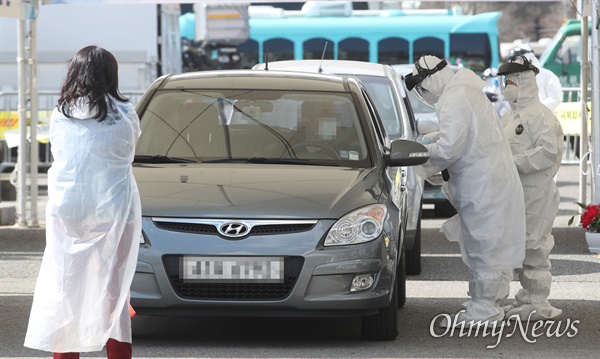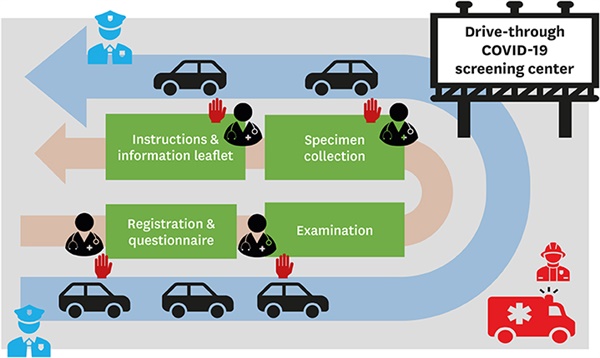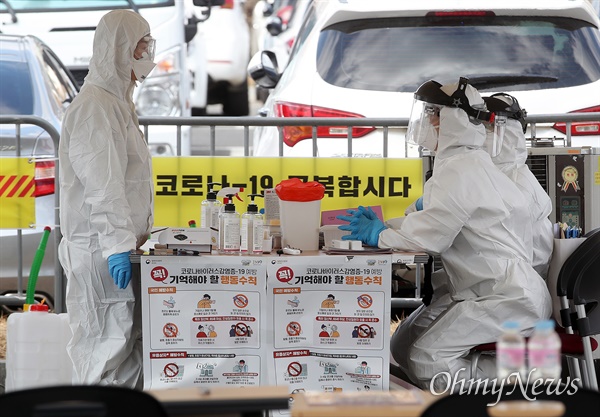큰사진보기

|
| ▲ On February 27th morning, the health workers are examining citizens who visited for the COVID-19 test at the ‘Drive-thru’ style screening center. Goyang ‘Drive-thru’ screening center was set up at the 1st public parking lot in Deokyang-gu, Gyeonggi-do Province. |
| ⓒ You Sung Ho | 관련사진보기 |
With COVID-19 spreading around the world, the medical teams in Korea have stepped up to share their 'Drive-thru' experience.
On March 16th, the online edition of JKMS(the Journal of Korean Medical Science) published the paper titled 'Drive-Through Screening Center for the COVID-19: a Safe and Efficient Screening System against Massive Community Outbreak.' The authors included Kim Jin-yong, Director of the Division of Infectious Diseases in Incheon Medical Center, and Kwon Ki-tae, Director of Infection Control at Chilgok Kyungpook University Hospital, who ran the first drive-through screening center in Korea.
Currently, there is a need for a safe and efficient inspection method desperately, as the group infection continues around local communities. The researchers thought about ways to meet the purposes and took hints from overseas papers on how to conduct large-scale tests in the context of an influenza pandemic and bioterrorism.
More Safely, More Efficiently
큰사진보기

|
| ▲ How to Operate the COVID-19 ‘Drive-thru’ Clinic: The main process is ‘Registration-Questionnaire-Specimen Collection-Information & Exit.’ The subjects are in their vehicle throughout the course, minimizing the risk of infection to the medical teams. |
| ⓒ JKMS. | 관련사진보기 |
According to the paper, 'Drive-Through' screening centers conduct the COVID-19 tests in the order as follows: ① Entrance ② Registration ③ Questionnaire & Examination ④ Specimen Collection ⑤ Instruction after the Test ⑥ Exit. During the whole process, the subjects stay in their vehicles and communicate with the medical staff mostly by cell phones to minimize contact. The automobile ventilation system should also be kept as the internal air circulation mode.
After a simple registration procedure, the medical team interviews to determine whether the subjects are infected with the COVID-19. This process can filter out patients with a low chance of the COVID-19, which requires the medical team to have sufficient expertise. However, it is hard to avoid the manpower shortage during the peak time when the virus is in full swing. This is why the Korean government and the Daegu city government appealed for volunteer medical staff around the end of February when the confirmed number of people started to come out in large numbers.
After sampling, the subjects leave the center after being informed about when and how the results will come out, how to self-isolate themselves until the result comes out, and how to contact the quarantine authorities if their symptoms worsen. The whole process is finished in about 10 minutes, so up to 100 people a day can be tested.
Also 'Drive-thru' can operate with much less resource than general medical centers that are difficult to secure the place itself and requiring ventilation systems as well as a lot of manpower. As a result, the first 'Drive-thru' screening center was set up at Chilgok Kyungpook University Hospital on February 23rd. Since then, it increased to 68 centers nationwide as of March 12th.
5 Things that Still Lack
큰사진보기

|
| ▲ On February 27th morning, the health workers are preparing to test the COVID-19 suspected cases at Goyang ‘Drive-thru’ style screening center. |
| ⓒ You Sung Ho | 관련사진보기 |
The researchers said they still have a few problems that should be solved. First, there is still a risk that health workers can be infected in the sampling process. It is almost impossible to replace all protective gear whenever the medical workers test the suspected cases. To make up for this, the researchers suggested that extra protective clothing, gloves be equipped, and that their hands be disinfected every time they test the cases. Second, because the health workers are outdoors throughout the entire process, there are restrictions on activity in winter.
Third, if a drive-through center is far from a hospital, taking follow-up measures can be difficult. Therefore, suspected patients in serious conditions are recommended to use clinics linked to hospitals rather than the drive-through centers. Fourth, only those with private cars are allowed to visit the centers. Fifth, because of the easier access than a typical clinic, there may be cases of overlapping examinations in multiple locations.
Still, the drive-through screening centers have been the force for South Korea to cope with the COVID-19 more safely and more efficiently. The researchers suggest that other countries can also operate drive-through screening centers according to their local circumstances to fight against the COVID-19. Moreover, they predict if diagnostic kits, treatments, and vaccines are developed, drive-through style clinics will be possible in the future.
Written by Sohee Park.
Translated by Youngae Joanna Kim.
* This report is the English version of OhmyNews Korean article. If you want to read the original article in Korean, click here!